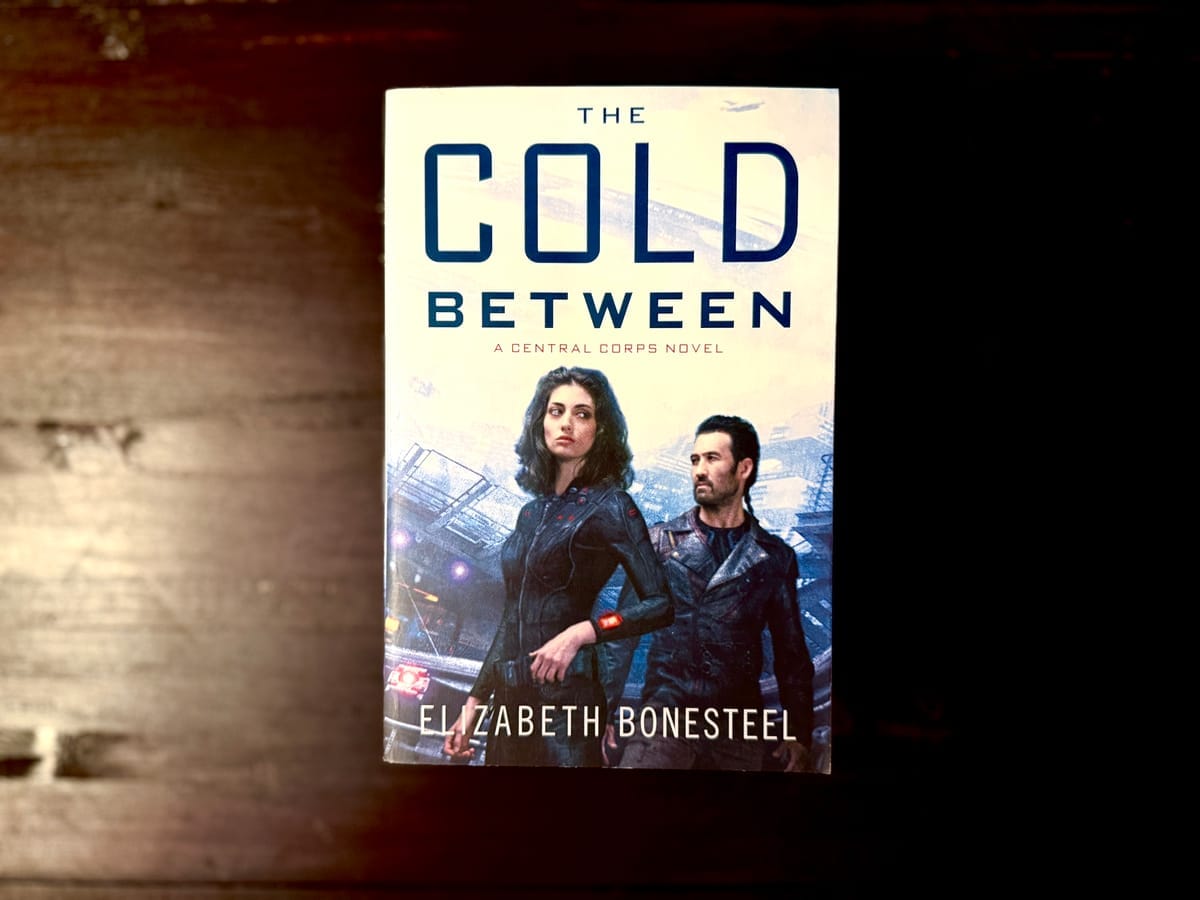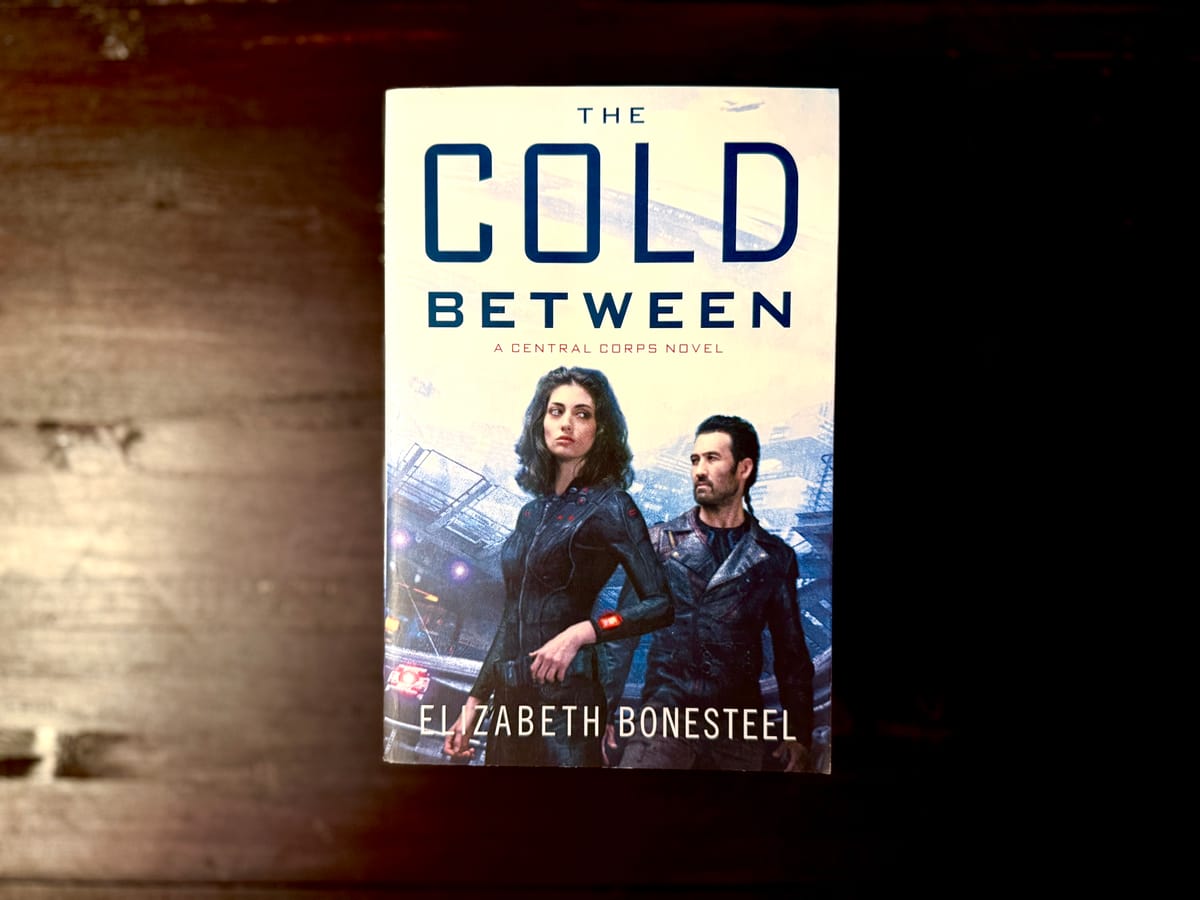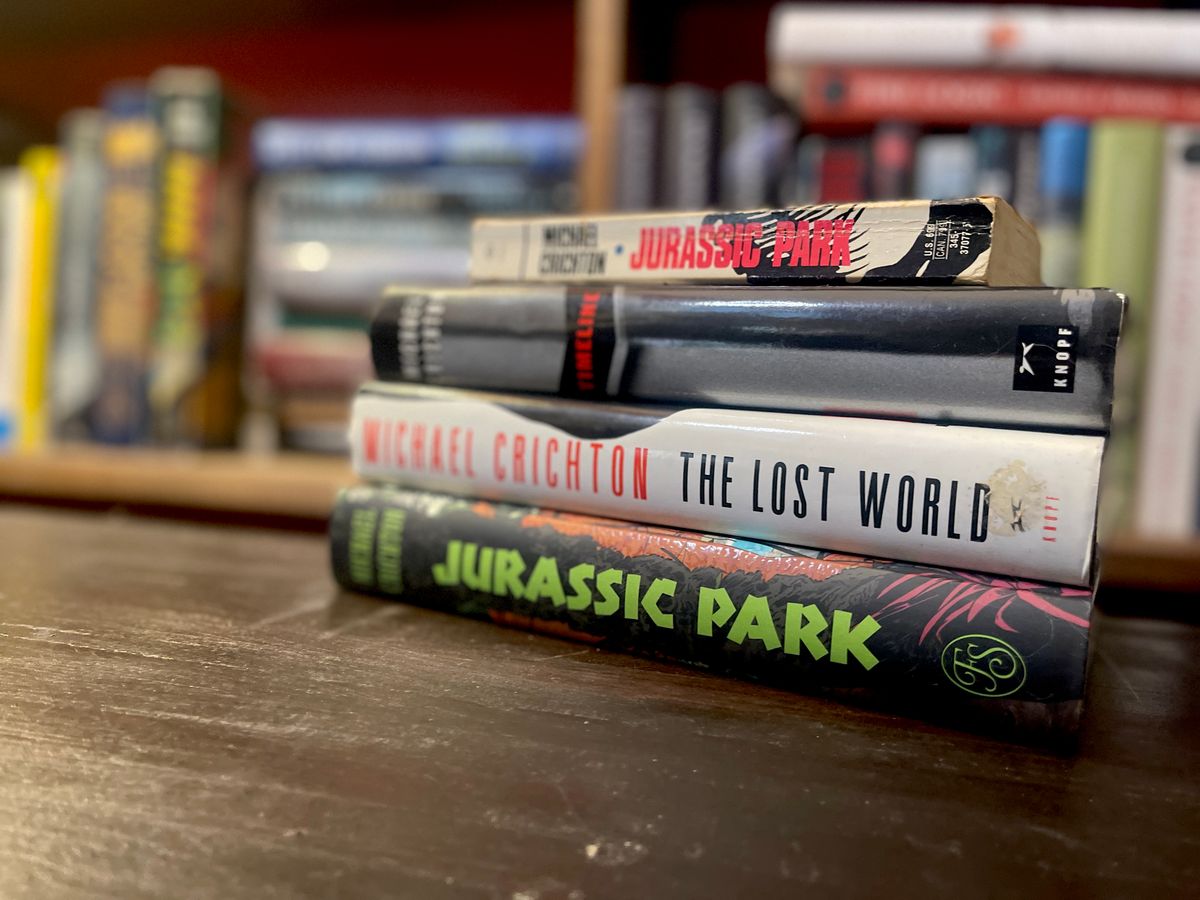Fitting a round peg into a genre-sized hole
Two authors talk about things not often talked about

One series of books that I really enjoyed when they first came out was Elizabeth Bonesteel's Central Corps novels (The Cold Between, Remnants of Trust, and Breach of Containment), a space opera series that hit all of the right buttons for me: space organizations, spaceships, weird mysteries, and some compelling characters.
The books came out between 2016 and 2017, and while I liked them and they seemed to have a lot of promise, the series never really took off: Bonesteel has written a handful of posts recently about her frustration with the publishing world, and why she's essentially thrown up her hands and opted to go the self-publishing route.

I've noticed an uncomfortable phenomenon recently. While assembling some lists on Bookshop.org for some of the earlier monthly book lists I publish here, I was surprised at how many of those books were coming up as not available, and appeared to be out of print – including some that had been launched with quite a bit of fanfare. You'd see them get a lot of attention, but just 2, 3, or 5 years later, it's harder to find them, and in some instances, it doesn't look like the authors have written anything since.
There are a lot of factors that go into this. Said authors could be writing under a different name, had career / life changes, or something. And publishing is a business: if one particular book isn't selling, they'll cut their losses: the book might not be reprinted, and if it's part of a series, the follow-up novels might get smaller print runs. That's hard in an industry that's driven by personalities and personal connections.
In her latest post, Bonesteel points to another issue: how mismatches in editors, agents, publishers, and authors can cause some considerable friction. She points to her debut novel, The Cold Between and how there were some efforts before the book was even published to try and pitch it to a certain audience: romance readers. The problem was: her book wasn't explicitly a romance. There was romance in it, but she'd envisioned it differently.
They played up the romantic elements of the plot. Which seemed fine at the time. I loved the romantic elements of the plot! But the marketing very quickly blurred, pushing the book toward romance reviewers who objected to the lack of a Happily Ever After for the romantic elements in question.
It's been a while, but I remember romance being an element that the marketing highlighted. Here's part of the original press release:
THE COLD BETWEEN is the start to a stellar military science-fiction series, with a hint of mystery and romance in the tradition of Lois McMaster Bujold.
Central Corps starship mechanic Elena Shaw doesn’t have time to grieve when her crewmate Danny is murdered during shore leave on the rich-but-lawless colony planet Volhynia. All evidence points to Treiko Zajec: former captain of one of the huge generation ships making up the mostly-benevolent outlaw tribe known as PSI, and Elena’s lover. But Elena knows Trey is innocent – he was with her when Danny was killed – and the cops are covering for the real killer.
Marketing, as she points out, "is about setting reader expectations. And if your publisher gets that wrong, the consequences can be dire." While her book got some decent reviews (mine included), the tenor changed when it hit the romance community and was trashed by a better-known author. As she notes:
But genre romance killed my career. My publisher looked wistfully at the buckets of money genre romance was making and decided to make my work an experiment. They thought they were being coy, using terms like “romantic elements,” which was fine until they started sending the book to romance reviewers.
That had a huge impact on the rest of the series. There were those diminishing returns, and after the last book was released in 2017, she parted ways with her agent and wasn't contracted to continue the series with Harper Voyager.
Last year, she wrote about how difficult the entire experience was:
On a personal level it was horrific. It dismantled a part of my life that had been important to me since early childhood, a part that I needed to function properly in the world. I had to take the shattered mess and rebuild it. It’s going on seven years now, and what I’ve learned is that while I may build something new, I’ll never get that part of my life back. That field has been poisoned and salted.
In another corner of the internet, Linda Nagata wrote on her blog that she recently got the rights to her novel The Red: First Light and sequels back from Saga Press, and provided an honest assessment of how they performed: not well.
She originally self-published The Red in 2013: it was a military science fiction novel set in the nearish future, following a US Army Lieutenant James Shelley who starts to hear voices from an implant that he has. It turns out that it's an artificial intelligence that has some protective tendencies, and begins steering him in different directions.
The book has the distinction of being the first self-published novel to earn a nomination for a Nebula Award – no small feat, considering that it was nominated alongside Neil Gaiman's The Ocean at the End of the Lane, Ann Leckie's Ancillary Justice, Helene Wecker's The Golem and the Jinni, and others. That nomination brought the book to the attention of Saga Press, which contracted Nagata to write two sequels, The Trials and Going Dark.

Again, these books were fairly well received: I reviewed them for various places and interviewed Nagata, but as she pointed out, "sales never amounted to much." That's always boggled my mind: it's an outstanding novel, and it really deserves to be widely read.
Publishers such as Orbit, Saga, and Tor have been on the lookout for breakout hits in the self-publishing world: look at the success of John Scalzi's Old Man's War, Andy Weir's The Martian, or Matt Dinneman's Dungeon Crawler Carl series: these are books that were successful in self-published form that publishers were able to pick up and bring to a wider audience. "Me, my agent, and my editor, all thought this was going to be my breakout novel," Nagata wrote, but that didn't happen in this case: the Red series just never caught on.
But I have to wonder if this was again how the books were pitched to readers and bookstores, with the complication of a prior, self-published edition floating around out there: the readers who had already picked up and nominated The Red had already read it. And while I'm a fan of near-future military science fiction, it's a tough genre: it's often thought of as a jingoistic and right-leaning genre (I disagree), and the traditional science fiction community doesn't seem to have a huge appetite for gritty technothrillers that really dig into the nature of warfare and artificial intelligence in the way these books do.
The line that you can draw between these two books is that they were written and envisioned as one thing, and the publishers had trouble finding the right combination of people to pitch it to. The Cold Between was aimed at genre romance readers and it didn't land, while The Red and its sequels didn't find the right collection of technothriller/military fiction fans.
These efforts are something that are generally invisible to readers. There's the adage that you only get one first impression, and I think that really holds true for books: if a publisher or author lays out a case for a book as being one genre or another, it does so with a whole bunch of signals: the body of critics that are pitched, the style and design of a cover, the title, language in the back-cover copy, and the blurbs from fellow authors, the way that the book is described and pitched to a bookstore. All of these things set a track for where the book ends up in the mind of the reader.
I've had some experiences with this: my own book, Cosplay: A History, is kind of hard to place. It's a history of the genre and cosplay, but it's also a book at fandom and technology. On the back cover descriptor, it's listed as "Social Sciences," and it's often stuck in a section where genre readers – the folks who this book is designed to appeal to – really aren't zooming over to when they enter a bookstore. You sort of have to know where to find it. Had it been placed in the section of Barnes & Noble alongside other books about movies and TV and entertainment, I have to imagine that it would have done a bit better.
This isn't anyone's fault: I had an excellent publicist, Lucy Nalen, who did a great job drumming up interviews, reviews, and other media attention leading up to its release: it got mentions in The New York Times and Washington Post, which let me tell you, isn't easy. But it's the underlying structure of publishing and publicity that made this book a bit harder to get to the right combination of readers.
Part of that issue, I think, is that readers are very easily swayed by those publicity efforts and don't realize it. Look at the books that most appeal to the traditional science fiction and fantasy fandom: these are readers who don't generally look outside of the catalogs put out by Tor, Orbit, Harper Voyager, Baen, etc.: those sales channels work really well, but the folks they're targeting for sales aren't generally going outside of those channels.
I'm trying not to slam the idea of a genre here: it's a good guidepost for readers. But where we do run into problems are when they're immutable and a publisher is fighting to stick a square novel into a genre that it doesn't quite fit into, as in the case of The Cold Between. This does readers a disservice: they're sold a book that doesn't conform to their expectations, and that can impact sales and even an author's career. I had a conversation with an author friend of mine who noted that while her books had romantic elements in it, she was finding that she was starting to get stuck into the romantasy bucket. Her books were ones that would appeal to those readers broadly, but weren't the sex-drenched romps that really draws those readers in.
I wrote about this a couple of years ago after a conversation I had with some folks on Twitter about Michael Crichton, and noted how difficult it was to get folks interested in books like K. Chess's Famous Men Who Never Lived (I had a lot of people yell at me online for reviewing this book when it was released, and other folks screaming at me that they'd never forgive me for recommending Tom Sweterlitsch's The Gone World) or Charlotte McConaghy's Migrations. Samantha Harvey's Orbital is a novel that's earned considerable critical acclaim (I'm reading it now and it's excellent), but it's had little-to-no attention from the readers who eat up this stuff.

I don't know what the solution for that particular problem is there, other than to point out that I've found it mentally healthy to read widely and to recognize genre for what it is: a marketing category that happens to line up well with a canonical body of work. I've gotten to the point where I find splitting hairs about genre tiring (one reason why I enjoyed Nnedi Okorafor's Death of the Author), and ultimately, just not productive when thinking about what a story is trying to convey.
But I do think that publishers need to take some time to really rethink how books are marketed to audiences – no small feat, given the volume that they have to move month-to-month. Publicity departments often fall to a small group of employees who might be juggling a huge number of titles, all of which comes down to one-on-one chats or emails with a group of reviewers and critics. I just spent 2-3 months launching and selling our COVID book in my day job and that entire process was exhausting! Because of the scale and volume, a lot of this comes down to sending out press releases to a broad audience and hoping that someone is picking up the phone.
To be fair: this is an approach that works! Look at some of the excellent, dense, complicated books that have come out in recent months / years. Audiences do find these things. But there are lots of instances where books just aren't given the priority or attention, and have to rely on coasting along with a bit of hope and luck attached. As a business practice, that doesn't strike me as a good or productive method.
I'm sure that there are also some ingrained habits and "this is how we do things" approaches and tactics, but I've often felt that the entire field is one where publishers should put more time and energy into experimenting and finding new ways to get their books before readers. I had a bunch of publicity meetings ahead of Cosplay's release and presented a whole bunch of ideas to try, none of which were picked up, while I was essentially laughed out of a newsroom for the wild idea that a publisher might consider some ancillary things to accompany a book release, like prints of cover art or knickknacks to reward super/devoted fans and build up some sort of fan identity around them.
I digress.
What Bonesteel and Nagata's posts highlighted and reinforced for me is how publishing as a whole is designed to operate in big, broad swaths: take X number of books and figure out how to get them to Y audience via bookstores, reviewers, and influencers.
That might work in a number of instances: an author's written a book that slots in nicely to a genre. But what these posts also highlight is that there are a lot of decisions that go into how these books are positioned, even as they're being written and edited, for the market. Does this particular character get changed around because an editor decides that it'll make the book fit better into this category? Or does the plot shift into a different direction because a particular audience found the book and that's what they're expecting? The logistics and machinery of the publishing industry has an impact on the content that it's creating, one that's at times highly responsive to audience feedback and commentary.
There's a good part of that that makes me uncomfortable: I like to think of art as the distillation of an author's experiences, views, and creativity, and when you start to inject these other factors in from a commercial standpoint, you run the risk of diverging from that original vision. I think of fans and readers being led along for the ride, rather than dictating where they'd like to go.
As both authors noted, there are plenty of options for them to jettison that entire framework. Nagata has been self-publishing her books for years, while Bonesteel has begun to do the same. Nearly a decade after she released her first Central Corps. novel, she's returning to the world with a new one: Condition of War, which is due out in June 2025. Nagata hasn't continued her Red series, but she did self-publish an excellent military thriller in a similar vein back in 2017, The Last Good Man, and is now selling ebook copies of her series directly. (The Red: First Light, The Trials, and The Dark.)
There's a tradeoff, but in each situation, it seems that they're comfortable with the switch. Hopefully, they'll have readers who'll follow them, and maybe find some new ones along the way.
These are the types of pieces that I like digging into for readers: things that examine the intersection of science fiction and the real world, and what it all means. If you found this piece informative, please consider signing up as a supporting subscriber: it helps keep the newsletter running.


